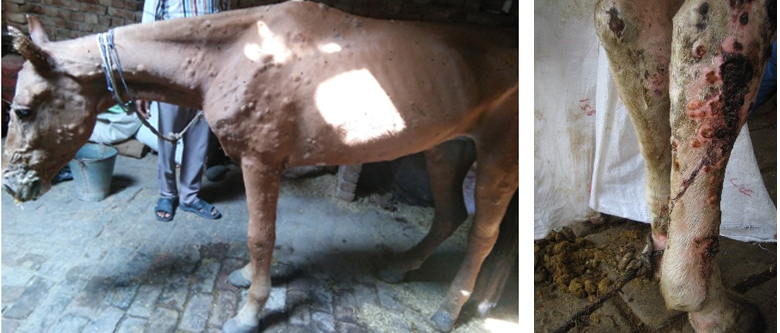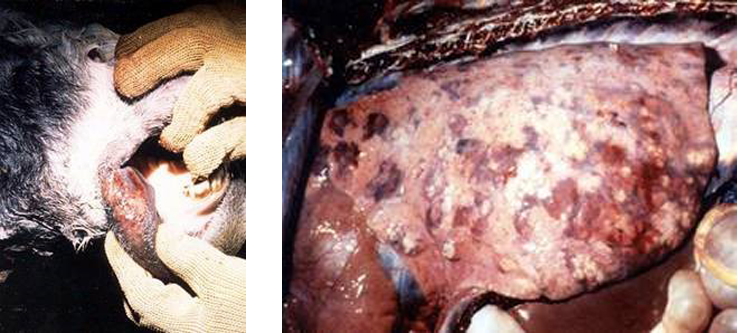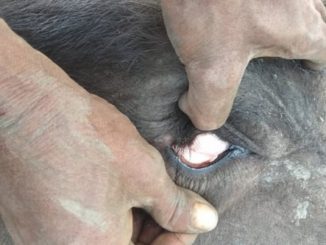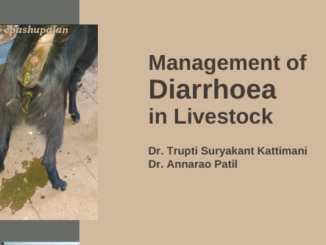Importance
Glanders is one of the most terrible zoonotic bacterial disease by which horses, mules and donkeys are primarily affected. Although it is quite uncommon for humans to get infected yet it is life threatening and painful. Humans- Without antibiotic treatment, the case fatality rate can be as high as 95%. Occasionally, Glanders has also been observed to occur in other mammalian species, particularly members of the feline family.

Etiology
Glanders has been found to essentially result from infection by Burkholderia mallei, which is a Gram negative rod in the family Burkholderiaceae. This organism was priorly known as Pseudomonas mallei.
History
Aristotle was the first person to provide a recorded description of glanders in third century. In 1664, glanders was recognized as a contagious disease and in 1830 its zoonotic potential was suspected. For the purpose of diagnosis of this disease, Mallein test was developed in the late 1800s. The turn of the century, saw all major developed countries of the world like U.S., Canada, and Great Britain implementing glanders-control programs.
During the course of World War I, it was believed that glanders was deliberately spread for the purpose of infecting large numbers of Russian horses and mules stationed on the Eastern Front. This affected the troops and supply convoys, as well as artillery movement because of their dependence on horses and mules. Human cases of glanders also increased in Russia during and after World War I.
It is a widely held theory that the enemy horses, civilians, and prisoners of war were infected intentionally with glanders by the Japanese to gain an upper hand during World War II. Though United States made detailed research for developing glanders as a possible biological weapon in 1943-44 but opted not to weaponize it. It is general belief that Soviet Union was interested in synthesizing B. Mallei in the form of potential biological weapon agent after World War II.
Transmission in Animals
- Ingestion: Major route
- Inhalation: Less likely
- Direct contact: Minor route
- Enhanced by shared food and water facilities
Transmission in Humans
- Direct contact with infected animals Abraded skin or Mucous membranes Inhalation
- Person-to-person (rare)
- Ingestion has never been recorded in humans
Who Is At Risk?
- Veterinarians
- Lab workers
- Butchers
- Groomers
- Horsemen
- Farriers

HOST RANGE:-
- Affects solipeds: Donkeys, mules and Horses
- Carnivores, humans and goats susceptible
- Swine and cattle resistant
Distribution: Asia, Africa and the Middle East
Glanders is very contagious to other equids and it can be transmitted to humans (Zoonotic).
The lungs, nasal cavity, lymphatic system and skin (a variant condition called farcy) have been observed to be affected with nodular abscesses. A sticky, purulent discharge is released once these nodules ulcerate. Skin exudates and respiratory secretions contain large numbers of bacteria that are easily spread by direct contact, fomites and environmental contamination.
Clinical Signs
- Acute form: Predominantly affects mules and donkeys in which death may occur within a few days.
- Chronic form: predominantly affects horses; the infection may persist for years.

Horses with chronic or latent infections often maintain the disease within the population as they act as reservoirs of infection.
Clinical signs of acute glanders are primarily respiratory and are more commonly observed in mules and donkeys.
- High fever
- Depressions, anorexia, coughing
- Swollen nostrils with septumulceration and a thick, mucopurulent haemorrhagic discharge.
- Multiple nodules and ulcers developing in the respiratory tract.
- Swollen/ ulcerated mucous membranes; the ulcers healing to form a typical star-shaped scarin those that survive.
- Swelling and abscessation followed by rupture of regional lymph nodes.
- Lung consolidation and pneumonia – round, firm greyish nodules developing in the lung tissue
- Severe respiratory distress
- Death within a few days

Farcy – Cutaneous Form Of Glanders
- Develops secondary to skin injury or respiratory disease.
- Superficial and/or deep subcutaneous abscess form with or without ulceration and inflammation of the local lymph nodes.
- Skin nodules can reach upto 2.5 cm diameter and may rupture releasing an infectious purulent discharge.
- Nodules develop on the head, neck, thorax, ventral abdomen and legs.
- Lymphatic vessels can become infected and abscessated, resulting in visible ‘farcy pipes’, or develop nodules – ‘farcy buds’.
- Causes weight loss.

Diagnosis
- Microscopic examination of a gram-stained smear of fresh material may reveal gram negative rods. The bacteria are non-sporolating and non- encapsulated.
- Bacterial culture is not recommended unless sent to a specialist laboratory due to the zoonotic nature of the pathogen. Be aware of the capabilities of the local diagnostic laboratory (e.g. NRCE Hisar Haryana).
Be aware that handling infected discharge containing the bacteria can result in infection; wear gloves at all times. It is important that laboratory technicians are made aware of the risks when handling infectious material.
Mallein Test
- The mallein test on a delayed hypersensitivity reaction in animals infected with glanders. This test is particularly useful in subclinical cases and is used as a prescriptive test for international trade. The protein is commercially available.
- Intrapalpebral injection of mallein protein derived from Burkholderia mallei bacteria.
- Equids infected with glanders, and/or farcy, develop marked eyelid swelling, fever and occasionally a purulent ocular discharge within 24 to 48 hours. Eyelid swelling is minimal in uninfected animals.
- This is a rapid field test for equids. Prompt confirmation of positive cases is crucial in infectious disease control to allow early intervention to limit spread.
- The mallein test is almost 100% specific although only 76% sensitive so there are likely to be more false negative results compared to false positives. It is essential to implement the isolation protocols for a suspected glanders case, pending further testing, even if negative in the mallein test.
- If the mallein protein is inadequately purified there are likely to be greater number of false positives.
In countries or areas where there are no diagnostics facilities, then a diagnosis has to be made based on clinical signs alone.
Necropsy finding
- Ulcers, nodules,
- stellate scars in upper respiratory tract Pneumonia
- Firm rounded miliary nodules
- Swollen lymph nodes and vessels

Differential Diagnosis
- Melioidosis: Burkholderia pseudomallei, Gram negative, Found in Soil & Water, Transmission through direct contact. Endemic in Vietnam & Australia
- Strangles: Streptococcus equid, No bleeding or Ulcer Formation, No skin eruptions, Guttoral pouch empyema
- Ulcerative Lymphangitis: Big Leg disease Corynebacterium pseudotuberculosis
- Epizootic Lymphangitis: Histoplasma farcimosum (Fungus), Skin eruptions usually on legs occasionally on head or neck.
Treatment
Euthanasia is recommended as a recovered animal remain a source of infection for others, including humans.
OIE lists glanders as a notifiable disease. Follow the prescribed protocols in countries with legislation regarding the control of glanders. It is essential that veterinarians are aware of local control policies.
In India, for example, there is a Glanders and Farcy Act which outlines that the nearest Government Veterinary Officer (GVO) should be notified of suspected cases. A GVO will carry out the sampling (nasal swab and serum) for diagnosis and send this to the National Research Centre on Equine (NRCE). If glanders is confirmed by laboratory diagnosis the affected equid is euthanased by government authorities and compensation is paid to the owner. The animal is disposed of hygienically, the area is disinfected and animals which have been in contact are assessed.
Sampling of Susceptible/in-Contact Animals Should be Carried Out as Follows
- Horses / Mule / Donkeys :- 100% -5 km around the nuclei infection, 50% -next 5 km above around the nuclei infection
- Extensive physical surveillance in districts around 50 kms. from the nucleus of infection should also be carried out.
- Public Awareness –Zoonotic significance.
Prevention and Control
In countries with no legislation or diagnostic facilities it is essential to implement the following protocol:
- Do not touch the animal with bare hands.
- Use facemask / disposable Gloves and isolate the animal immediately.
- Dig a 2 – meter deep hole in the ground, enthanase the animal and bury it; OIE recommends burning the animal prior to burial.
- Clean and disinfect the area where the animal was living and working. Iodine is an effective disinfectant.
- Destroy harness and grooming equipment.
- Monitor any in-contact animals and humans. Initial indications of infection generally include a high fever and the eruption of nodules. Isolate suspect cases.
- Attempt to notify the government and OIE of the case and inform local human health authorities.

|
The content of the articles are accurate and true to the best of the author’s knowledge. It is not meant to substitute for diagnosis, prognosis, treatment, prescription, or formal and individualized advice from a veterinary medical professional. Animals exhibiting signs and symptoms of distress should be seen by a veterinarian immediately. |






Wonderful n useful article
Explained in an absolutely informative manner.Felt really enlightened after reading this masterpiece😇
Appreciable work
Really Appreciable
Informative one👍
Great work ma’am .
This is very well information… Gr8 work mam… Carry on☺☺☺
Important information. Please provide it in the hindi/regional also , it might be great help of equine owners & the nation also.
Nice mam it’s too beneficial for us . Thanx ..
concise n informative article
Very informative. Keep up the good work👍
Well explained informative article in a simple language. Good work Dr. Meenakshi 👍
Very information article
Very informative article mam
Well done. Informative article
Quite informative
Very informative article mam..
Nicely presented
Good work👍
Great work mam….article is very useful and informative….really hard work….excellent….👍👍👍👍
Great work mam …,thank you for this valuable information.
Nicely written mam
Informative content👍
Very nicely expressed by Dr.Meenakshi Rawat. Liked it:)
Thx mam for valuable information
Very useful n informative article👍👍All the best ma’am!!keep the good work going👍
Very useful n informative article👍👍All the best ma’am 😊
Good Knowledge, information and very useful… Great Job. Great article
Dr Maneekashi Ji, I read your whole article carefully and found that you are deeply studied about animals and their disease that’s why you explain these information in details. I highly appreciate your uncommon work which is very essential to everyone’s in such a critical circumstances. I hope you are not stopped here because You are Genius, So God bless you for your future endeavors.
Good articles on Glander and quite an informative and helpfull for veterinarian.
Nice info
Great work Dr.Meenakshi ji.
Great work Dr meenakshi.. informative article
Dear talented grand meenakshi, extremely thoroughly written hunky-dory article. It certainly proves your prudential genuineness towards profession Animal Husbandry. Proud of you. Keep the good work going. With best wishes
Dear talented grand meenakshi, extremely thoroughly written hunky-dory article. It certainly proves your prudential genuineness towards profession Animal Husbandry. Proud of you. Keep the good work going. Best wishes
very informative. Spread the word 👍🏻
Nicely explained. I got a better understanding of the disease, thanks to you ma’am.
Information arctical .. nice
Impressive n informative article meenakshi mam👍👍✌✌
Really a nice information share by Dr. Meenakshi ji
Very informative article. Keep it up.
The hard work that you have put is commendable, The article is made didactic to assimilate for everyone who reads this. must say a phenomenal work done!
it’s really informative good work
This is very important article for students Dr meenakshi
Great work Dr meenakshi
Good job doxab &discribe in detail
Excellent Job…
Great work Meenakshi ji.It’s very useful and informative article for all. 👏🙏
Very informative and concise.
Great work Meenakshi
Very useful n ellaborative article.
Great work Meenakshi
This document is very useful for everyone who engaged in rearing of equines and service providers. Best wishes.
Really hard work
Hope many more in future….
Carry on ..
Very useful article
Very useful Article
Well descriptive and ellaborative article. It is very much useful for professionals and students as well.
Quite an informative article. Enjoyed reading it.
🙏😊